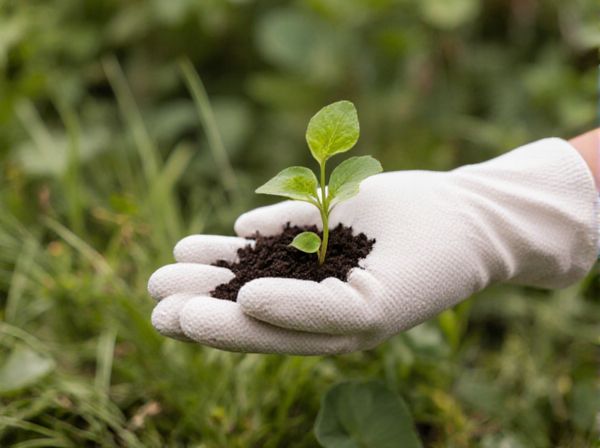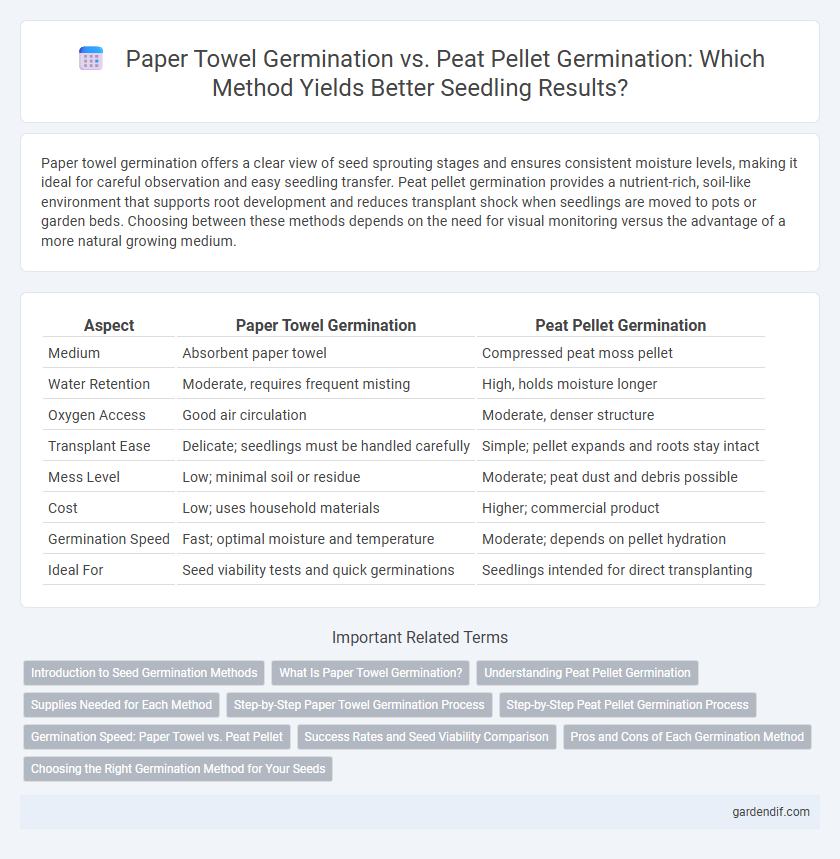
Paper Towel Germination vs Peat Pellet Germination Illustration
Paper towel germination offers a clear view of seed sprouting stages and ensures consistent moisture levels, making it ideal for careful observation and easy seedling transfer. Peat pellet germination provides a nutrient-rich, soil-like environment that supports root development and reduces transplant shock when seedlings are moved to pots or garden beds. Choosing between these methods depends on the need for visual monitoring versus the advantage of a more natural growing medium.
Table of Comparison
| Aspect | Paper Towel Germination | Peat Pellet Germination |
|---|---|---|
| Medium | Absorbent paper towel | Compressed peat moss pellet |
| Water Retention | Moderate, requires frequent misting | High, holds moisture longer |
| Oxygen Access | Good air circulation | Moderate, denser structure |
| Transplant Ease | Delicate; seedlings must be handled carefully | Simple; pellet expands and roots stay intact |
| Mess Level | Low; minimal soil or residue | Moderate; peat dust and debris possible |
| Cost | Low; uses household materials | Higher; commercial product |
| Germination Speed | Fast; optimal moisture and temperature | Moderate; depends on pellet hydration |
| Ideal For | Seed viability tests and quick germinations | Seedlings intended for direct transplanting |
Introduction to Seed Germination Methods
Paper towel germination offers a controlled environment for observing seed sprouting through moisture retention and ease of monitoring root development. Peat pellet germination provides a nutrient-rich, organic medium that supports seedling growth while reducing transplant shock due to minimal root disturbance. Both methods serve as effective introductory techniques for understanding seed germination and early plant development.
What Is Paper Towel Germination?
Paper towel germination is a technique where seeds are placed between moist paper towels to create a controlled, humid environment that promotes rapid sprouting. This method allows for easy monitoring of seed development and uniform moisture distribution, which enhances germination rates. Paper towel germination is cost-effective and ideal for small-scale seed testing or starting seedlings before transferring them to soil or peat pellets.
Understanding Peat Pellet Germination
Peat pellet germination offers a nutrient-rich, moisture-retentive environment that mimics natural soil conditions, promoting robust seedling growth and stronger root development. Unlike paper towel germination, peat pellets provide a bioactive medium that reduces transplant shock and enhances microbial activity essential for healthy plants. This method is especially beneficial for seedlings requiring consistent moisture and aeration for optimal germination rates.
Supplies Needed for Each Method
Paper towel germination requires simple supplies such as paper towels, water, a resealable plastic bag, and seeds, making it ideal for quick, indoor seed starting. Peat pellet germination involves peat pellets, a tray or container to hold the pellets, water for expansion, and seeds, offering a nutrient-rich medium that supports early root development. Both methods require minimal materials but differ in their growing medium and setup complexity.
Step-by-Step Paper Towel Germination Process
Place seeds between two damp paper towels to create a moist environment that promotes germination. Keep the paper towels inside a plastic bag or container to maintain humidity and store them in a warm, dark location for 3-7 days, checking daily for moisture and sprout development. Once roots appear, carefully transplant the seedlings into soil or peat pellets to support further growth.
Step-by-Step Peat Pellet Germination Process
Peat pellet germination involves hydrating the compressed peat until fully expanded, creating an ideal moisture-retentive environment for seed sprouting. Seeds are then carefully placed on the surface of the swollen pellet, which provides organic nutrients and aeration critical for root development. Maintaining consistent humidity and warmth during the initial days ensures robust seedling establishment before transplantation.
Germination Speed: Paper Towel vs. Peat Pellet
Paper towel germination often results in faster seed sprouting, as it maintains consistent moisture and allows oxygen flow directly to the seeds. In contrast, peat pellet germination tends to be slower due to peat's denser composition, which can limit oxygen availability and delay water absorption. Studies show paper towels can reduce germination time by up to 30% compared to peat pellets, making them ideal for rapid seed propagation.
Success Rates and Seed Viability Comparison
Paper towel germination offers quick and clear observation of seed viability, with success rates typically ranging from 75% to 95% depending on seed type and moisture control. Peat pellet germination provides a more natural growing medium, enhancing root development and often resulting in higher transplant success rates, generally between 80% and 90%. Seed viability tends to be better preserved in peat pellets due to consistent moisture and nutrient availability, whereas paper towels may cause uneven drying and reduced seedling vigor.
Pros and Cons of Each Germination Method
Paper towel germination offers fast seed sprouting and easy monitoring of moisture and root development, but it risks seedling damage during transplanting and requires consistent humidity control to prevent drying out. Peat pellet germination provides a nutrient-rich, biodegradable growing medium that reduces transplant shock and supports root growth, yet it can harbor mold if overwatered and tends to be more expensive than paper towels. Selecting between methods depends on the balance of convenience, seedling protection, and environmental control tailored to the specific plant species.
Choosing the Right Germination Method for Your Seeds
Choosing the right germination method depends on seed type, moisture needs, and environmental control. Paper towel germination offers quick visibility of sprouting seeds and allows precise moisture regulation, ideal for small-scale or experimental planting. Peat pellet germination provides a nutrient-rich medium that supports root development and reduces transplant shock, making it suitable for longer germination periods and robust seedling growth.
Paper Towel Germination vs Peat Pellet Germination Infographic

 gardendif.com
gardendif.com